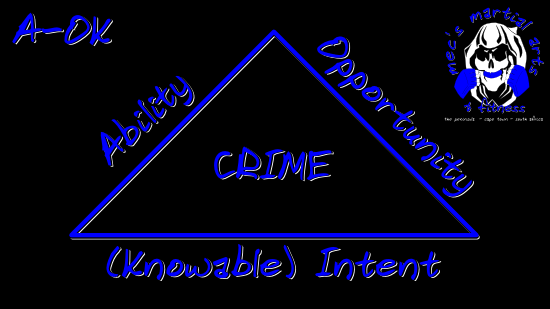
A triangle showing Crime bounded by Ability, Opportunity, (Knowable) Intent.
The diagram above & the acronym (A-OK) give a quick reference to determine whether you are in danger in a particular situation or not. The idea is that all 3 sides need to be present for a crime to be committed. If you become aware of one side it is important to raise your level of awareness & be on the lookout for the other 2. If you are aware of 2 then it would be wise to stop whatever else you are doing & become vigilant & start looking for a way out...
Ability
- Is the person/s able to successfully attack you?
- Could your potential assailant/s overwhelm you?
- Through superior numbers?
- Do they have weapons?
A potential attacker will always be assessing their own ability to overwhelm you while staying as safe as possible. This gauging process is often referred to as the 'interview'. There are 4 generally used forms of interview:
- Regular: The most common form especially among muggers & stranger rapists. A simple request for directions, small change, the time etc. The request is just a distraction. Always insist that anyone approaching you on a pretext remain at a safe distance. If they refuse or become belligerent your fears have been confirmed.
- Hot: This is a sudden emotionally charged verbal attack. The assailant is hoping that the attack will stun & confuse.
- Escalating: Usually starts as a normal approach but quickly escalates. It often becomes increasingly hostile or relies on increasingly outrageous behaviour. Your boundaries are being tested, the assailant is testing to see how far you can be pushed before defending yourself. This is a common tactic with date rapists but is also used by muggers.
- Silent: Here the assailant doesn't expose themselves or make contact until they are ready to attack. They position themselves & observe while out of sight. This makes this a very difficult interview to spot. The interview may be short / opportunistic or prolonged as in a stalking.
In each case the potential assailant is checking whether you are aware of what is going on & your ability / determination to defend. All the while he / they are positioning for the attack. Which brings us to the next side of the triangle...
Opportunity
- Are you alone / isolated?
- Out of reach of immediate assistance?
- Is there a distraction?
The opportunity for attack seldom occurs in crowded areas, it is more likely to happen when you are close to people but just out of range. Think of the parking area of your local mall compared to the mall itself. Don't forget quiet areas at parties, fairs, concerts etc. A large portion of the opportunity is related to the attackers successful positioning. The common forms are:
- Closing: simply closing the gap with the 'victim' enhances the potential to overwhelm & control. This is why the regular interview is so common. Remember to enforce a safe distance.
- Cornering: here the would be assailant approaches in such a way that you are trapped between them & a large object (wall, car etc.) or in a corner. Be careful to ensure you have a way out.
- Surprise: being grabbed from behind a wall or a bush. This approach is used in conjunction with the silent interview. Be aware of any potential hiding places & make sure you don't get close enough to be grabbed.
- Pincer: here 1 will distract while the other/s circle around or flank you. You are effectively trapped between 2 or more assailants. Be aware of individuals that might be linked in an area that is potentially dangerous & avoid getting between them. If you are approached use quarter turns to ensure you can see them & others approaching.
(Knowable) Intent
Naturally a crime won't occur without intent, but since we aren't mind readers we have to rely on body language & other 'tell-tales'. When we subconsciously pick up on these signs we get a 'gut feel', our 'spider sense tingles' or we call it intuition. This is one of the reasons for the knowable in parenthesise. The other major reason is that if you ever consider using self-defence as a legal defence (please read this before you do) you cannot speak of the others intent, only of the signs that gave rise to your feeling the need to defend yourself. Paying attention for these signs could be the difference between being attacked or not. In particular when the other 2 prerequisites (ability & opportunity) are present.
Self-Defence Training at Mec's Martial Arts
Mec's self-defence programme uses a layered approach to self-defence:
- Common Sense
- Diplomacy
- Strategy
- Tactical
It is unreasonable to believe that all situations can be resolved reasonably....